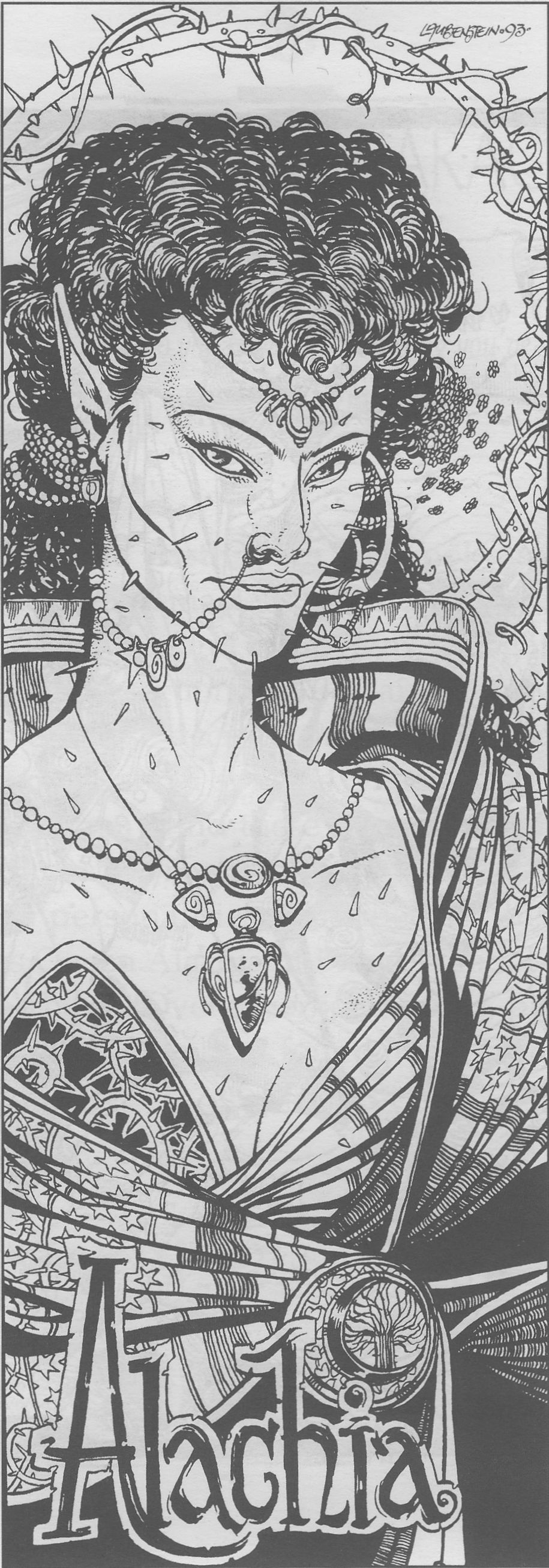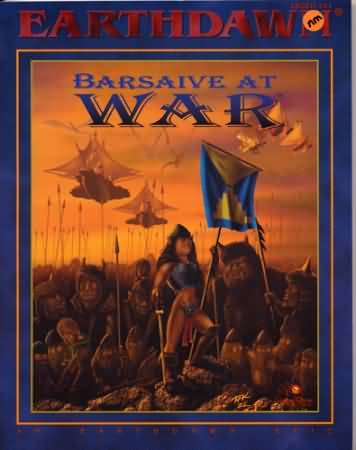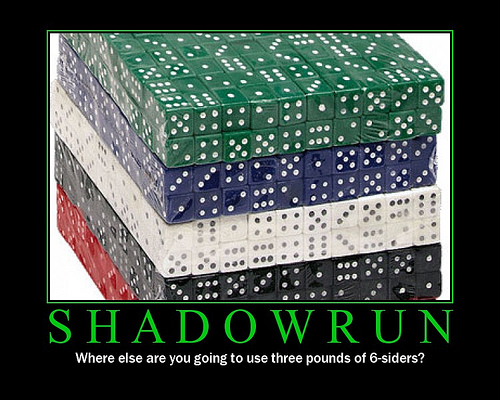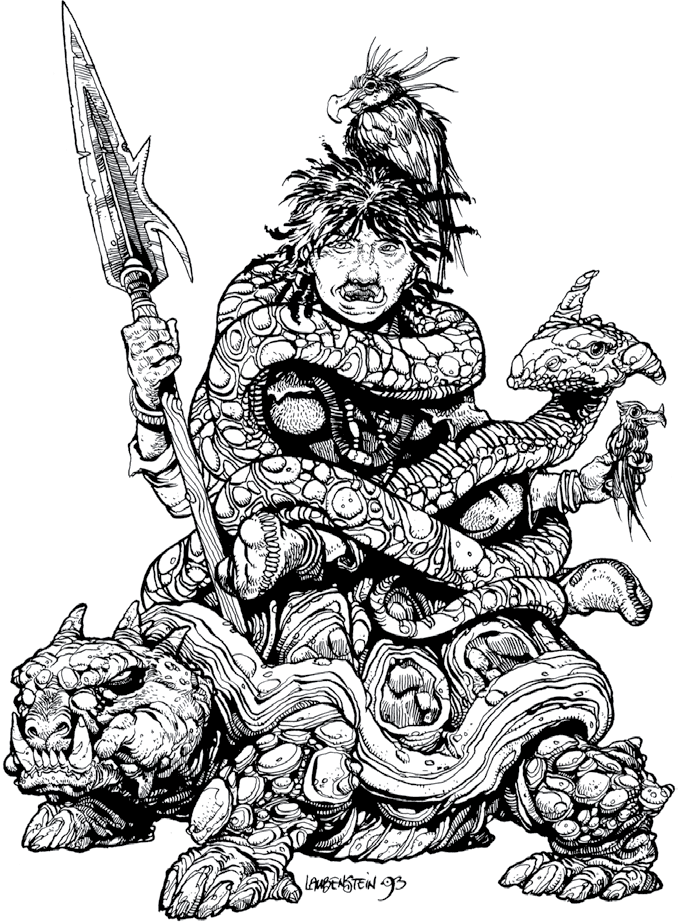
The year is 1993, and FASA (the makers of Shadowrun) have decided that they want to make an actual D&D clone. They had done very well with their Tolkien/Cyberpunk mashup, and it was in its 2nd edition. So the step to bringing the fight to D&D's doorstep by making a fantasy adventure RPG probably made sense to somebody. In order to tie it to their earlier (and more successful) work, FASA made their fantasy adventure game set in Shadowrun's distant past – an earlier age of magic.
Ancient History and I are coming to this book from very different places. At the time, my reaction to Earthdawn was basically “What the fuck is this shit?!” I sort of expected that if I got promised an “earlier age of magic” that I would be given something that could at least maintain plausible deniability as to being the real history of the Earth. Because Shadowrun takes place in a world that is supposed to look like our world until December of 2011, so any previous age of magic would kind of need to be superficially similar to our actual history. Instead, we get a high magic crazy time where the Black Sea is on fire and the Earth has been nearly scoured of life by roving demon hordes. There is absolutely no fucking way that historians could have not noticed this time period. Also, it's full of anachronisms and it really pissed me off.
The Earthdawn writers weren't actually trying to make something that was remotely plausible as the secret history of Earth. And that's right there where they lost fourteen year old Frank. What they were trying to do was to create a world where the basic tropes of D&D adventuring actually made sense to the people in-world. And I might have given the game more of a chance back then if they had leveled with me instead of selling it to me on false pretenses.
Depending on how you look at it, Earthdawn is either the most or least ambitious project that the Freedonian Air and Space Administration ever put out. It is unequivocally a shot across the bow at Dungeons & Dragons and all its many clones, released at a time when AD&D was dying, showing how a newer, more vital company could give a new and loving approach to the old grognard's standard. They brought with them all that they'd learned of roleplaying games at that point - high production values, outstanding presentation, a colorful and engaging setting that was carefully integrated with the rules system, and not buying model designs from American licensees of Japanese animated robot shows.
As Frank mentioned, it's pretty much supposed to be the age of magic before Shadowrun. In fact, in early (early early early) promotional materials it was explicitly called that. But it was set in a corner of the world no-one fucking recognized (at least I didn't) and it was, as he pointed out, a weird mishmash of stuff, which later sourcebooks didn't exactly help with.
But it was...fun. It was a fun setting. It had colorful books that were well-written and illustrated. It answered a lot of gaping flaws in the D&D concept, and it did it well. Not all of them, but a lot. It was amazingly consistent, as FASA products were, and surprisingly resilient. After FASA cancelled the line, Living Room Games picked it up for a 2nd edition, and then RedBrick Ltd. picked up another license for a 3rd edition, and now FASA is back and releasing a revised 3rd edition or something.
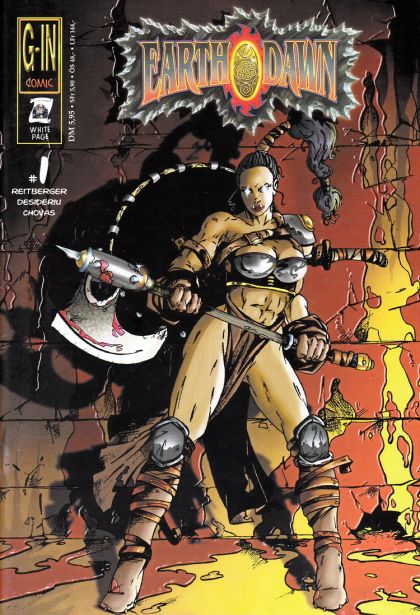
This is the cover to one of the German Earthdawn comics. Fucking Germans get everything nice.
Earthdawn is 328 pages long, which doesn't seem like a lot today. But in 1993 it was definitely on the long side. This is the forward edge of the word processor revolution that would eventually drown all major RPGs in word bloat. The font size is not overly tiny and there are a lot of pictures. All told, this book clocks in at a bit over two hundred thousand words. And honestly, that's about right. It's longer than what came before it, and that was OK. Unfortunately, it is historical reality that the same processes that led to Earthdawn being over two hundred thousand words eventually led to shovelware crap like Scion and Geist to be over three hundred thousand words. It would have been nice if somehow there had been a general agreement to leave new game books at the size of Earthdawn, but it was not to be.
A moment to talk about the title: "Earthdawn" is, like Shadowrun or Battletech, an evocative and ultimately pithy title. It speaks of new things, primeval times, and all that. But it is also very specifically the name of a ship, an airship sent out to investigate the world which disappeared. It's kinda weird to think of it like that, because it puts me in mind of The Voyage of the Princess Ark.
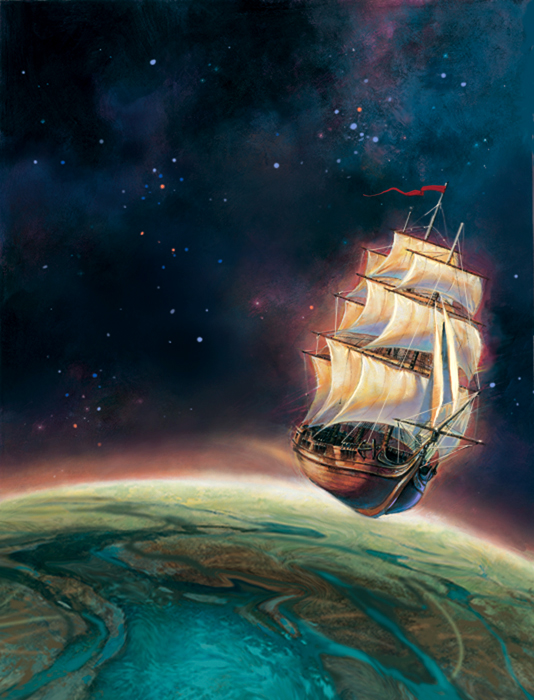
Yes, I made a Mystara reference. Sue me.
Earthdawn is developed by Mulvihill, Dowd, and Prosperi – three names that you would recognize from the front covers of a lot of Shadowrun books. RPG writing is an incredibly incestuous field even today, and in the days before people could send writing samples through the internet tubes, it was even more so. FASA really wasn't that big a company, and while they made more of an attempt to be international than most companies of the period, their available talent pool was still pretty small. The names on this credits page could have been copypasta from the credits page of any Shadowrun book of the time and you wouldn't know.
One thing I will say in its favor is that the writing team is refreshingly small. There is one guy on “Design” and four names on “Additional Material”, which means you basically have a five person writing team, one of whom is in charge of “design,” three of whom are in charge of “development” and one of whom has to get coffee for the other four dudes who all outrank him. Compared to the dozen author shovelware products of the mid-2000s, this is an amazingly tight and coherent focus. And it shows in the final product. Earthdawn looks like material that was actually written as a unit rather than the essays of a dozen people lazily strung together and then edited by a website. That shouldn't be a thing we have to comment on, but considering where the industry was ten to twenty years later, we actually do.
The incestuousness continues with the art team, who are predominantly Shadowrun artists. The most fondly-remembered of these is Jeff Laubenstein, and any of his elf, dwarf, ork, or troll characters in ED could pretty much stand in for their SR counterparts. Later books even got a Brom cover.
A word on the layout and incidental art - there's an odd combination of influences going on here, a sort of deliberate mishmash of ancient styles, especially a heavy Mayan/Aztec influence. I think this was part of their plan to throw people off their game as to what to expect...or maybe there was one guy that really liked drawing pseudo-Mayan heiroglyphs and giant stone heads. It sort of came to a head with the Parlainth boxed set, but I think it says something about how early FASA was at least trying to show a more multicultural product, even if it was all being done by a bunch of white people in Chicago.

Age of Legend
The heroes of today are the legends of tomorrow.
Earthdawn begins every chapter, even very short chapters, with an in-world quote. I approve. I do the same exact thing in my work, because I had my formative years in the early nineties as well. It's a good way to ease people into a chapter, and it sets a continuous tone for the work as a whole. By the mid-2000s, most game companies had stopped doing this, and it's a mistake.
Anyway, the “Age of Legend” chapter is about as short as they come – just three pages. And one of those pages is less than half a page because it's the intro page and is in a big font. This is an introductory preamble more than a chapter as such, but it still gets an opening quote.
It's also an excuse to get the "what is Earthdawn?" and "What is roleplaying" crap out of the way as quickly and succinctly as possible.
FASA publishes game supplements and adventures to aid the gamemaster, but talented gamemasters always adapt the game universe to suit their own style.
The opening is actually where Earthdawn lost me in 1993. It lost me in the second paragraph:
My problem with this is that there was really obviously not a period in the last couple thousand years where the trees and animals of the Earth were driven to extinction by Horrors. That is not a thing that fucking happened. So basically, Earthdawn to me was like The Phantom Menace. Someone had announced that they were making a prequel to a property I loved, and then when I picked it up it turned out they shat all over canon and made something that was in no way compatible with the stuff I actually liked and I was pissed off.Earthdawn wrote:Once, long ago, the land grew lush and green. Thriving forests sheltered plants and animals, and people grew and prospered off the land's bounty. Then the Horrors came, and drowned the world in darkness.

The Horror!
But really, the tie-ins with Shadowrun were always 2nd order or 3rd order. It really makes more sense to look at this like an alternate universe or something. There are references to each in the other one, but they aren't really the same world and you'll only hurt yourself if you try to make them fit together. Essentially, this is like cameos from old cartoons in the dark future of Samurai Jack – it's homage rather than an indication of real setting compatibility. The authors of Earthdawn assume that you're familiar with Shadowrun – which is why the T'skrang and Windlings get brief descriptions on the first page and Orks, Trolls, Elves, and Dwarves all just name checked. But that's really as far as it goes.
Not that they ever really explained that in any satisfactory way. If they had, 14 year old Frank probably wouldn't have put this book down in disgust. At least, not this early in the reading.
The origins of Earthdawn precede the actual publication by a fair bit. The 1st edition Shadowrun rulebook had hints about ancient elves and previous ages of magic and "where the fuck did dragons and Sperethiel come from anyway?" The whole core conceit of the Shadowrun setting was the magic comes back. So eventually they decided to actually write the game.
Now, like Frank said, while this was obviously a Shadowrun tie-in, it was equally obviously made not to be a game where you could port characters back in forth. Earthdawn is set in some indeterminate past -- well, until Findley gave a date for the destruction of Atlantis in Tir Tairngire and a bunch of geeks (including yours truly) broke out their calculators. Anyway, yeah, it doesn't jive with what we know about the geology and paleontology of the Earth, and it's actually not set far enough back into the dim recesses of pre-history to work either (and that's before we get to the Theran Empire sourcebook). But if you keep in mind that this is just set arbitrarily far back into the past of Shadowrun and that magic eventually erased all the evidence of mass extinctions and shit, it's all in good fun.
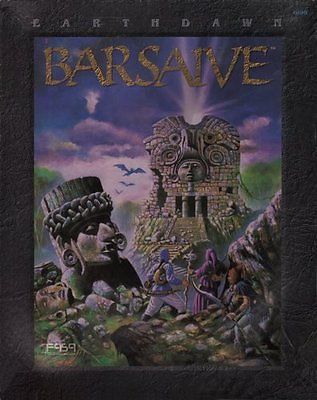
Boxed sets are another thing RPGs have gone away from.
The intro is surprisingly information dense. This is actually the kind of economy of language that modern RPG writing really needs to get back to. They lay out the basic premises pretty tightly: the world was destroyed by demons from the depths of astral space, but before that happened people hid themselves in magical fallout shelters. Now, the space demons are on the wane, and it is time for badass heroes to wander the post-apocalyptic wasteland and try to reclaim the world and re-establish contact with the bomb shelters that made it, and explore and loot the ones that did not.
In short: it's D&D. There's a presented reason why there are dungeons full of monsters and treasures and evil humanoids, and there's a presented reason why heroes get into small groups and invade those dungeons. And there's a presented reason why the wilderness is full of chimeric monsters and why some of them would be quite close to civilized lands. It is, in short, a pseudo-scientific reboot of the typical D&D world. They even have an in-world rationalization for characters leveling up. Looking through this, this really looks exactly like it was somebody's homebrew AD&D campaign setting, and that it was given its own game system because the D20 system wouldn't come out with a license allowing people to make officially D&D compatible games for 7 more years. The Shadowrun connections in particular seem like a last minute inclusion.
Well, we'll get to that. 5 of the 8 player character races are pretty explicitly ported from Shadowrun. But yeah, ED doesn't require any knowledge of Shadowrun to appreciate, nor does Shadowrun require any ranks in Earthdawn Lore to meander through it's plot and sourcebooks. It was really just a very extended series of Easter eggs for dedicated fanboys like me.

Earthdawn pretty much assumes that you've played RPGs before, and at least some of the authors seem to be assuming you've played Shadowrun before. They even suggest that the “What is Roleplaying” section may be old news to you and you might want to skip it. However, I think it's interesting to see where a group of authors are coming from when they write an RPG. The “What is Roleplaying” may not be a helpful section for an experienced roleplayer to read, but it's an important section to read if you want to know if you're on the same wavelength as the author(s).
Earthdawn's “What is Roleplaying” is pretty much straight Arneson. It's like a movie or a book, but you get to decide what the characters do. This is almost word for word Dave Arneson's thing about how people in fantasy books do stupid shit and he felt that he could do better. It gives this book a very old school D&D feel.
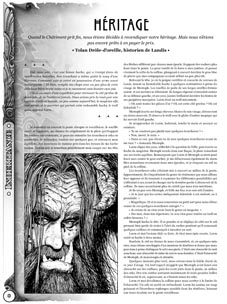
This is from one of the French additions. See that image in the lower-left? If you turn the page in the English-language hardback 1st edition rulebook, that's a full-page illustration on the right-hand page. The caption is "Lorm was an unhappy troll..."
I love Earthdawn.
Inheritance
When the Scourge ended, we were determined to reclaim our heritage. But we were not yet ready to pay the price.
This chapter is a story. It is 8 pages of fiction, but one of those pages is a fullpage line drawing of a trollface.
Not exactly.
The actual story begins with an anachronism. The story teller would like a Dwarf stout. But of course, stouts were invented in the 17th century CE, so Dwarves or no Dwarves that shit wouldn't be available for a couple of thousand years. Which gets us to the real point, which is that this setting is only set in the ancient past when it remembers. It looks like it was originally some dude's long running D&D campaign, which means it was probably supposed to be set in the future rather than the past before a last minute marketing decision decided to make it into a prequel.
Anyway, the fact that they use a Troll major character is significant, because it suggests that the story was hacked out quite late in the design process. Simply put: Trolls are in the mix because they are in Shadowrun and the company wanted the tie-in. Elves, Humans, Dwarves, and Orks are in because it's a D&D setting, and the T'skrang, Windlings, and Obsidimen are in the mix because everyone who made themselves a custom D&D setting in the late seventies and early eighties made themselves some custom races. We're just lucky there aren't Ducks or Chuweros. Trolls almost certainly weren't in the original draft, which means that there's like an entire decade of proto-Earthdawn material where Trolls as we know them don't exist. So there's probably a major character Troll in the opening fiction because someone went through the book and put in Troll references so they wouldn't feel “tacked on.” It almost works.
The 8-page intro fiction was pretty standard for FASA. It was standard for every edition of Shadowrun they ever put out, and the basic idea was always the same: get the best writer you can and have them churn out an evocative piece of fiction that will drag the readers into the game world. I'm with Frank in this that the piece was done late in the process; I wouldn't be surprised if it was done last, after all the setting material was written and in layout already.

This is a troll viking skyraider jumping out of an airship.
The actual story itself is about a team of adventurers going into a dungeon and failing to kill a Horror. The Horrors are the big bad of the setting. The story takes time to write up some of the Earthdawn magics, and the descriptions are quite evocative. However, the characters don't really do anything bad ass. One of the characters wounds the demonic antagonist with an ax and then escapes with his life. This establishes the enemies as powerful and a thing to be feared, but it doesn't really establish the potential PCs as big damn heroes. I think this perspective is why in my experience, Earthdawn has always appealed more to GMs than to players.
The book spends a lot of time fapping to how unbeatable the big villains of the setting are, and a lot less time discussing how your player characters can make a fuck's worth of difference.
This is something I think...I don't want to say it was Mike Mulvihill or Tom Dowd, but one of those guys had a hard on for certain inevitability in life. They like the idea that there were some things you couldn't fight, some wars you couldn't win. Superman can't punch poverty, Earthdawn can't fight all the Horrors - one or two of the Horrors, if you're powerful and lucky, but not all of them, not all at once. They wanted to paint the people that cowered and hid under the earth during the Scourge as the smart monkeys; it makes the people who didn't - like the Blood Elves - and what they did to themselves to survive all the more plausible. It adds an element of horror that D&D never really established, even in Ravenloft. Desperation, impossible choices, nasty magic - and I mean nasty magic! Shadowrun had always played up blood magic, but Earthdawn actually let you play with it...

This is a living windling trapped in amber. It was the major artifact of the initial Earthdawn anthology Talisman, and it was created by blood magic. That windling was awake and screaming, eyes trapped open staring at the Horrors for the entire Scourge. It was a good anthology.
Next up... And So It Came To Pass...





